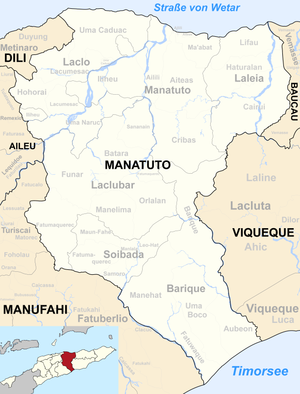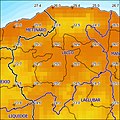Laclo (Administrative Office)
| Administrative office of Laclo | ||
|
|
||

|
||
| Administrative headquarters | Laclo | |
| surface | 283.29 km² | |
| population | 7,756 (2015) | |
| Sucos | Population (2010) | |
| Hohorai | 969 | |
| Lacumesac | 2.156 | |
| Laicore | 1,017 (2017 new) | |
| Uma Caduac | 3,433 | |
| Uma Naruc | 1,198 | |
| Overview map | ||

|
||
Laclo ( Lacló , Laculo , Lakló , Lucló , Luclo ) is an East Timorese administrative office ( Portuguese Posto Administrativo ) in the municipality of Manatuto . The seat of the administration is in Suco Uma Caduac in Laclo .
geography
Until 2014, the administrative offices were still referred to as sub-districts . Before the 2015 territorial reform, Laclo had an area of 368.74 km². Now there are 283.29 km².
The Laclo Administrative Office is located on the north coast of Timor . To the east is the Manatuto administrative office and the Laclubar administrative office to the south . To the east Laclo borders on the administrative offices of Metinaro ( municipality of Dili ) and Remexio ( municipality of Aileu ). The river system of the Northern Laclós runs through the entire administrative office. It is one of the few rivers in the north of Timor that has water all year round, as it is fed from the south.
Laclo is divided into five sucos : Hohorai , Lacumesac ( Laku Mesak ), Uma Caduac ( Umacaduac , Umakaduak ) and Uma Naruc ( Umanaruk ). The Suco Laicore was newly created in 2017 from territories that were initially given to the Suco Iliheu (Administrative Office of Manatuto) in 2015 and have now returned to Laclo.
The Important Bird Area around Mount Curi takes up most of the north of Laclos on the coast.
- Climate data
Residents
7,756 people live in the Laclo administrative office (2015), of which 3956 are men and 3800 women. The population density is 27.4 inhabitants / km². The largest language group are the speakers of the national language Galoli . The high proportion of teenage mothers in the administrative office is striking. There are 101.5 live births per 1000 girls between the ages of 15 and 19 per year. This is the fourth highest value nationwide (national average: 59.2), but is still below El Salvador 's worldwide high of 108 births. On average, a woman in the administrative office has 7.25 children in her lifetime. Accordingly, the average age is 17.5 years (2010, 2004: 17.0 years).
history
Laclo was one of the traditional kingdoms of Timor, ruled by a liurai . It appears on a list by Afonso de Castro , a former governor of Portuguese Timor who listed 47 empires in 1868. The Laclo Liurai belonged to the Mambai ethnic group .
A Catholic church had existed in Laclo since 1752.
In the spring of 1861 revolts broke out against the forced labor on public projects. Afonso de Castro then sent Cabeira , a veteran and expert on the country, to set up a base in Manatuto . But he could only fall back on a few troops from Vemasse . There was already fighting in April. On August 26, the rebellion in Laclo was put down. The rebel camp was burned down and local allies were allowed looting and headhunting of the rebels. In June 1863 an uprising in Laga was put down. The rebel chief was captured by Laclo.
During the 1912 Manufahi Rebellion , fighting broke out again in the region. Jaime do Inso , second lieutenant of the Portuguese gunboat Patria, reported three heads that had been hung in Laclo.
On September 4, 1975, as a result of the civil war , FRETILIN units attacked Hatu Conan (Lacumesac) and captured twelve UDT members. Nine of them were murdered.
In 1976 Laclo was a retreat of the FALINTIL , who fought against the Indonesian invaders. Here they established a base de apoio , a resistance base, the refuge for refugees from the former district Manatuto, Dili and Aileu offered.
In 1977 hungry refugees who had dared come down from the mountains to harvest their fields were driven out by Indonesian soldiers. The soldiers burned the gardens and shot the cattle.
In May 1978 the Indonesians began attacking the Idada resistance base in the hills of Hatu Conan. From July the East Timorese resistance fighters were surrounded and destroyed. Rockwell OV-10 aircraft , which the United States had sold to Indonesia, were also used. Prisoners were first taken to the battalion post in Ili-Mano (Suco Uma Caduac), then to Metinaro , where the prison camp was later converted into a resettlement camp where the East Timorese were held. In August 1979, the male prisoners from Laclo were brought back home, where they built barracks. The women followed in October. At the end of 1979 there were also Indonesian camps for East Timorese in Laclo and Behau , who were supposed to be relocated by the Indonesian occupiers for better control. The residents of Laclo were only allowed to farm in the immediate vicinity on the stony subsoil. Almost every day people died of hunger and disease, until in 1980 the Indonesian army allowed them to cultivate their fields again. The remote areas of the sub-district have been depopulated. From 1970 to 1980, Laclo's population decreased by 45.1% from 6,512 to 3,578 people.
On September 6, 1999, the residents of Laclo expected an attack by the pro-Indonesian Mahodomi militia and the Indonesian army. People fled to the woods but then returned to their homes later that day. They fled again the next day when the police and the military burned down public buildings and the militia patrolled the streets. At least four people were murdered and many others were gunshot wounded.
politics
The administrator of the administrative office is appointed by the central government in Dili. In 2015 it was Mário Filomeno Sarmento Cabral .
economy
46% of the households in Laclo grow corn, 41% coconuts, 39% cassava, 34% vegetables, 26% rice and 12% coffee. Rice cultivation takes place mainly in the river system of the Northern Laclos.
There are small deposits of marble to the north and west of Laclo . This is the case with Ilimano (Suco Uma Caduac), where the deposits were already used in the Portuguese colonial times and the Indonesian occupation. At Behau you can still see large blocks on the road between Dili and Manatuto, which come from commercial mining.
Personalities
- Manuel Cárceres da Costa , politician
Web links
Individual evidence
- ↑ a b c d e Direcção-Geral de Estatística : Results of the 2015 census , accessed on November 23, 2016.
- ↑ Jornal da República : Diploma Ministerial no 24/2014 de 24 de Julho - Orgânica dos Postos Administrativos ( Memento of March 4, 2016 in the Internet Archive )
- ↑ a b Direcção Nacional de Estatística: 2010 Census Wall Chart (English) ( Memento from August 12, 2011 in the Internet Archive ) (PDF; 2.5 MB)
- ↑ Jornal da República: Diploma Ministerial n ° 16/2017 , with corrections dated May 9, 2017 , accessed on March 12, 2019.
- ↑ Birdlife International IBAs in Timor-Leste ( Memento from November 22, 2008 in the Internet Archive ) (PDF; 2 MB)
- ↑ a b Seeds of Life
- ↑ Direcção Nacional de Estatística: Census of Population and Housing Atlas 2004 ( Memento of November 13, 2012 in the Internet Archive ) (PDF; 14 MB)
- ↑ TIMOR LORO SAE, Um pouco de história ( Memento of November 13, 2001 in the Internet Archive )
- ↑ East Timor - PORTUGUESE DEPENDENCY OF EAST TIMOR ( Memento of February 21, 2004 in the Internet Archive )
- ↑ History of Timor - Technical University of Lisbon ( Memento of March 24, 2009 in the Internet Archive ) (PDF; 824 kB)
- ↑ "Chapter 7.2 Unlawful Killings and Enforced Disappearances" (PDF; 2.5 MB) from the "Chega!" Report of the CAVR (English)
- ↑ a b c d "Chapter 7.3 Forced Displacement and Famine" (PDF; 1.3 MB) from the "Chega!" Report of the CAVR (English)
- ↑ Ministério da Administração Estatal: Administração Municipal ( Memento from June 1, 2016 in the Internet Archive )
- ↑ Direcção Nacional de Estatística: Suco Report Volume 4 (English) ( Memento from April 9, 2015 in the Internet Archive ) (PDF; 9.8 MB)
Coordinates: 8 ° 33 ' S , 125 ° 55' E






